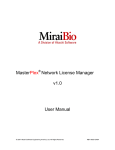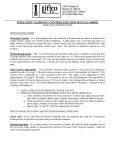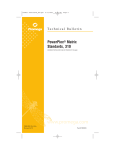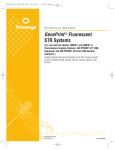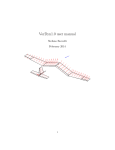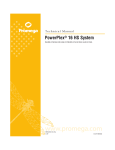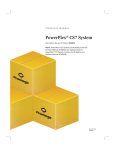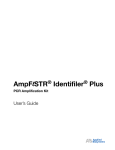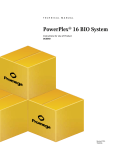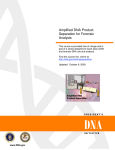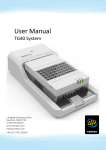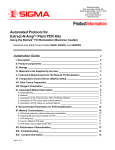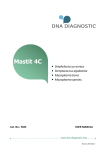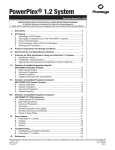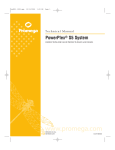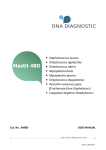Download PowerPlex® 2.1 System
Transcript
tmd011.0708.qxp 2/16/2009 3:18 PM Page 1 Technical Manual PowerPlex® 2.1 System INSTRUCTIONS FOR USE OF PRODUCTS DC6470 AND DC6471 PRINTED IN USA Revised 7/08 Part# TMD011 tmd011.0708.qxp 2/16/2009 3:18 PM Page 1 PowerPlex® 2.1 System All technical literature is available on the Internet at: www.promega.com/tbs/ Please visit the web site to verify that you are using the most current version of this Technical Manual. Please contact Promega Technical Services if you have questions on use of this system. E-mail: [email protected] 1. Description..................................................................................................................................2 2. Product Components and Storage Conditions ....................................................................3 3. Before You Begin .......................................................................................................................4 4. Protocols for DNA Amplification Using the PowerPlex® 2.1 System ............................5 A. Amplification Setup.........................................................................................................5 B. Amplification Thermal Cycling .....................................................................................7 5. Detection of Amplified Fragments Using the Hitachi FMBIO® and FMBIO® II Fluorescence Imaging Systems ..................................9 A. Polyacrylamide Gel Preparation....................................................................................9 B. Gel Pre-Run.....................................................................................................................11 C. Sample Preparation and Loading................................................................................12 D. Gel Electrophoresis ........................................................................................................13 E. Detection..........................................................................................................................13 F. Reuse of Glass Plates .....................................................................................................14 6. Data Analysis ...........................................................................................................................15 A Controls ...........................................................................................................................15 B. Allelic Ladders................................................................................................................15 C. Results..............................................................................................................................16 7. Troubleshooting.......................................................................................................................20 8. References .................................................................................................................................22 9. Appendix ...................................................................................................................................25 A. Advantages of STR Typing...........................................................................................25 B. Advantages of Using the Loci in the PowerPlex® 2.1 System.................................25 C. Fluorescent STR Products .............................................................................................28 D. Power of Discrimination ...............................................................................................29 E. Methods for Polyacrylamide Gel Reuse .....................................................................31 F. DNA Extraction and Quantitation Methods..............................................................33 G. The Internal Lane Standard 600...................................................................................33 H. Agarose Gel Electrophoresis of Amplification Products (Optional)......................34 I. Composition of Buffers and Solutions........................................................................35 J. Related Products ............................................................................................................36 Promega Corporation · 2800 Woods Hollow Road · Madison, WI 53711-5399 USA · Toll Free in USA 800-356-9526 · Phone 608-274-4330 · Fax 608-277-2516 · www.promega.com Printed in USA. Revised 7/08 Part# TMD011 Page 1 tmd011.0708.qxp 2/16/2009 3:18 PM 1. Page 2 Description STR (short tandem repeat) loci consist of short, repetitive sequence elements 3–7 base pairs in length (1–4). These repeats are well distributed throughout the human genome and are a rich source of highly polymorphic markers, which may be detected using the polymerase chain reaction (5–8). Alleles of STR loci are differentiated by the number of copies of the repeat sequence contained within the amplified region and are distinguished from one another using radioactive, silver stain or fluorescence detection following electrophoretic separation. The PowerPlex® 2.1 System(a–d) allows co-amplification and three-color detection of nine STR loci. The PowerPlex® 2.1 System contains the loci Penta E, D18S51, D21S11, TH01, D3S1358, FGA, TPOX, D8S1179 and vWA. One of the two primers for Penta E, D18S51, D21S11, TH01 and D3S1358 is labeled with fluorescein (FL) and one primer specific for FGA, TPOX, D8S1179 and vWA is labeled with carboxytetramethylrhodamine (TMR). All nine loci are amplified simultaneously in a single tube and analyzed in a single gel lane. The PowerPlex® 16 Monoplex System, Penta E (Fluorescein) (Cat.# DC6591) is available to amplify the Penta E locus. This monoplex system allows amplification of a single locus to confirm results obtained with the PowerPlex® 16 System, PowerPlex® 16 BIO System or PowerPlex® 2.1 System. The monoplex systems also can be used to re-amplify DNA samples when one or more of the loci do not amplify initially due to nonoptimal amplification conditions or poor DNA quality. The PowerPlex® 2.1 System is customized for use with the Hitachi FMBIO® and FMBIO® II Fluorescence Imaging Systems. The PowerPlex® 2.1 System provides all of the materials necessary for amplification of STR regions of purified genomic DNA except for AmpliTaq Gold® DNA polymerase. This manual contains separate protocols for use of the PowerPlex® 2.1 System with the Perkin-Elmer model 480 and GeneAmp® PCR system 9600, 9700 and 2400 thermal cyclers in addition to protocols for separation of amplified products and detection of separated material. Protocols for operation of the fluorescencedetection instruments should be obtained from the instrument manufacturer. Information on other Promega fluorescent STR systems is available upon request from Promega or online at: www.promega.com. For information about detecting amplified STR fragments using silver staining (9) refer to the GenePrint® STR Systems Technical Manual #TMD004. Promega Corporation · 2800 Woods Hollow Road · Madison, WI 53711-5399 USA · Toll Free in USA 800-356-9526 · Phone 608-274-4330 · Fax 608-277-2516 · www.promega.com Part# TMD011 Page 2 Printed in USA. Revised 7/08 tmd011.0708.qxp 2. 2/16/2009 3:18 PM Page 3 Product Components and Storage Conditions Product PowerPlex® 2.1 System Size 100 reactions Cat.# DC6471 Not For Medical Diagnostic Use. Cat.# DC6471 contains sufficient reagents for 100 reactions of 25μl each. Includes: Pre-amplification Components Box (Blue Label) 1 × 300μl Gold ST★R 10X Buffer 1 × 250μl PowerPlex® 2.1 10X Primer Pair Mix 3μg K562 DNA High Molecular Weight (10ng/μl) Postamplification Components Box (Beige Label) 1 × 150μl PowerPlex® 2.1 Allelic Ladder Mix 1× 150μl Internal Lane Standard (ILS) 600 1 × 1ml Bromophenol Blue Loading Solution 250μl Gel Tracking Dye 1 Protocol Product PowerPlex® 2.1 System Size 400 reactions Cat.# DC6470 Not For Medical Diagnostic Use. Cat.# DC6470 contains sufficient reagents for 400 reactions of 25μl each. Includes: Pre-amplification Components Box (Blue Label) 4 × 300μl Gold ST★R 10X Buffer 4 × 250μl PowerPlex® 2.1 10X Primer Pair Mix 3μg K562 DNA High Molecular Weight (10ng/μl) Postamplification Components Box (Beige Label) 4 × 150μl PowerPlex® 2.1 Allelic Ladder Mix 4× 150μl Internal Lane Standard (ILS) 600 2 × 1ml Bromophenol Blue Loading Solution 250μl Gel Tracking Dye 1 Protocol The PowerPlex® 2.1 Allelic Ladder Mix is provided in a separate, sealed bag for shipping. This component should be moved to the postamplification box after opening. Storage Conditions: Store all components at –20°C in a nonfrost-free freezer. The PowerPlex® 2.1 10X Primer Pair Mix, PowerPlex® 2.1 Allelic Ladder Mix and Internal Lane Standard 600 are light-sensitive and must be stored in the dark. The postamplification components are packaged separately to prevent crosscontamination. We strongly recommend that pre-amplification and postamplification reagents be stored and used separately with different pipettes, tube racks, etc. Promega Corporation · 2800 Woods Hollow Road · Madison, WI 53711-5399 USA · Toll Free in USA 800-356-9526 · Phone 608-274-4330 · Fax 608-277-2516 · www.promega.com Printed in USA. Revised 7/08 Part# TMD011 Page 3 tmd011.0708.qxp 2/16/2009 3:18 PM 2. Page 4 Product Components and Storage Conditions (continued) Available Separately Product Internal Lane Standard 600 Size 150μl Cat.# DG1701 For Laboratory Use. Additional fluorescent STR multiplex product information and ordering information for accessory components and related products is provided in Section 9.J and is available on the Internet at: www.promega.com or upon request from Promega. 3. Before You Begin The application of PCR-based typing for forensic or paternity casework requires validation studies and quality-control measures that are not contained in this manual (10,11). The quality of the purified DNA, as well as small changes in buffers, ionic strength, primer concentrations, choice of thermal cycler and thermal cycling conditions, can affect PCR success. We suggest strict adherence to recommended procedures for amplification, as well as electrophoresis and fluorescence detection. PCR-based STR analysis is subject to contamination by very small amounts of nontemplate human DNA. Extreme care should be taken to avoid crosscontamination when preparing sample DNA, handling primer pairs, assembling amplification reactions and analyzing amplification products. Reagents and materials used prior to amplification (Gold ST★R 10X Buffer, PowerPlex® 2.1 10X Primer Pair Mix and K562 DNA High Molecular Weight) should be stored separately from those used following amplification (PowerPlex® 2.1 Allelic Ladder Mix, Internal Lane Standard 600, Bromophenol Blue Loading Solution and Gel Tracking Dye). Always include a negative control reaction (i.e., no template) to detect reagent contamination. We highly recommend the use of gloves and aerosol-resistant pipette tips (e.g., ART® tips, Section 9.J). Some of the reagents used in the analysis of STR products are potentially hazardous and should be handled accordingly. Table 1 describes the potential hazards associated with such reagents. Table 1. Hazardous Reagents. Reagent Hazard acrylamide ammonium persulfate bisacrylamide formamide (contained in the Bromophenol Blue Loading Solution and Gel Tracking Dye) TEMED urea suspected carcinogen, toxic oxidizer, corrosive toxic, irritant irritant, teratogen corrosive, flammable irritant Promega Corporation · 2800 Woods Hollow Road · Madison, WI 53711-5399 USA · Toll Free in USA 800-356-9526 · Phone 608-274-4330 · Fax 608-277-2516 · www.promega.com Part# TMD011 Page 4 Printed in USA. Revised 7/08 tmd011.0708.qxp 4. 2/16/2009 3:18 PM Page 5 Protocols for DNA Amplification Using the PowerPlex® 2.1 System Materials to Be Supplied by the User • model 480 or GeneAmp® PCR System 9600, 9700 or 2400 thermal cycler (Applied Biosystems) • microcentrifuge • 0.5ml GeneAmp® or 0.2ml thin-walled MicroAmp® reaction tubes or MicroAmp® optical 96-well reaction plate (Applied Biosystems) • 1.5ml amber-colored microcentrifuge tubes (Fisher Cat.# 05-402-26) • aerosol-resistant pipette tips (Section 9.J) • AmpliTaq Gold® DNA polymerase (Applied Biosystems) • Nuclease-Free Water (Cat.# P1193) • Mineral Oil (Cat.# DY1151, for use with the model 480 thermal cycler) We routinely amplify 1–2ng of template DNA in a 25μl reaction volume using the protocols detailed below. Preferential amplification of smaller loci can occur. Expect to see more intense bands for smaller loci and relatively less intense bands for larger loci if more than the recommended amount of template is used. Reduce the amount of template DNA or the number of cycles to correct this. Primer concentrations are optimized for use with the GeneAmp® PCR systems 9600 thermal cycler and AmpliTaq Gold® DNA polymerase as described in the amplification protocol provided below. Thermal cycling conditions are also provided for the GeneAmp® PCR system 9700 and 2400 and Perkin-Elmer model 480 thermal cyclers. Use of AmpliTaq Gold® DNA polymerase is always recommended. DNA template of 5ng or greater results in an imbalance in more intense bands from locus to locus. The smaller loci show greater amplification yield than larger loci. Reduce the number of cycles in the amplification program by 2 or 4 cycles (i.e., 10/18 or 10/16 cycling) to improve locus-to-locus balance. 4.A. Amplification Setup The use of gloves and aerosol-resistant pipette tips is highly recommended to prevent cross-contamination. Keep all pre-amplification and postamplification reagents in separate rooms. Prepare amplification reactions in a room dedicated for reaction setup. Use equipment and supplies dedicated for amplification setup. ! Meticulous care must be taken to ensure successful amplification. A guide to amplification troubleshooting is provided in Section 7. 1. Thaw the Gold ST★R 10X Buffer and PowerPlex® 2.1 10X Primer Pair Mix. Notes: 1. Mix reagents by vortexing for 15 seconds before each use. Do not centrifuge the 10X Primer Pair Mix, as this may cause the primers to be concentrated at the bottom of the tube. 2. A precipitate may form in the Gold ST★R 10X Buffer. If this occurs, warm the solution briefly at 37°C, then vortex until the precipitate is in solution. Promega Corporation · 2800 Woods Hollow Road · Madison, WI 53711-5399 USA · Toll Free in USA 800-356-9526 · Phone 608-274-4330 · Fax 608-277-2516 · www.promega.com Printed in USA. Revised 7/08 Part# TMD011 Page 5 tmd011.0708.qxp 2/16/2009 3:18 PM Page 6 4.A. Amplification Setup (continued) 2. Determine the number of reactions to be set up. This should include positive and negative control reactions. Add 1 or 2 reactions to this number to compensate for pipetting error. While this approach does waste a small amount of each reagent, it ensures that you will have enough PCR master mix for all samples. It also ensures that each reaction contains the same master mix. 3. Place one clean, 0.2ml or 0.5ml reaction tube for each reaction into a rack, and label appropriately. Alternatively, use a MicroAmp® plate, and label appropriately. Note: If using the GeneAmp® PCR System 9600, 9700 or 2400 thermal cyclers, use 0.2ml MicroAmp® reaction tubes. For the Perkin-Elmer model 480 thermal cycler, we recommend 0.5ml GeneAmp® thin-walled reaction tubes. 4. In the order listed, add the final volume of each reagent listed in Table 2 into a sterile, 1.5ml amber-colored tube. Mix gently. Table 2. PCR Master Mix for the PowerPlex® 2.1 System. PCR Master Mix Component1 nuclease-free water Gold ST★R 10X Buffer PowerPlex® Volume Per Number of Final × = Reactions Volume Reaction 17.05μl 2.5μl 2.1 10X Primer Pair Mix 2.5μl AmpliTaq Gold® DNA polymerase2 0.45μl (2.25u) total volume 22.5μl 1Add nuclease-free water to the PCR master mix first, then add Gold ST★R 10X Buffer, PowerPlex® 2.1 10X Primer Pair Mix and AmpliTaq Gold® DNA polymerase. The template DNA will be added at Step 6. 2Assumes the AmpliTaq Gold® DNA polymerase is at 5u/μl. If the enzyme concentration is different, the volume of enzyme must be adjusted accordingly. Note: If the volume of AmpliTaq Gold® DNA polymerase added to the master mix is less than 0.5μl, you may wish to dilute the enzyme with 1X Gold ST★R Buffer first and add a larger volume. The amount of NucleaseFree Water in the reaction should be adjusted accordingly so that the final volume of master mix per reaction is 22.5μl. Do not store diluted AmpliTaq Gold® DNA polymerase. 5. Pipet 22.5μl of PCR master mix into each reaction tube, and place at room temperature. Promega Corporation · 2800 Woods Hollow Road · Madison, WI 53711-5399 USA · Toll Free in USA 800-356-9526 · Phone 608-274-4330 · Fax 608-277-2516 · www.promega.com Part# TMD011 Page 6 Printed in USA. Revised 7/08 tmd011.0708.qxp 2/16/2009 6. 3:18 PM Page 7 Pipet 2.5μl of template DNA (1–2ng) for each sample into the respective tube containing 22.5μl of PCR master mix. Note: If the template DNA is stored in TE buffer, the volume of DNA added should not exceed 20% of the final reaction volume. Amplification efficiency and quality can be greatly altered by changes in pH (due to added Tris-HCl), available magnesium concentration (due to chelation by EDTA) or other PCR inhibitors, which may be present at low concentrations depending on the source of the template DNA and extraction procedure used. 7. For the positive amplification control, dilute K562 DNA to 0.4–0.8ng/μl. Pipet 2.5μl (1–2ng) of diluted K562 DNA into a reaction tube containing 22.5μl of PCR master mix. 8. For the negative amplification control, pipet 2.5μl of nuclease-free water (instead of template DNA) into a reaction tube containing 22.5μl of PCR master mix. 9. If using the GeneAmp® PCR System 9600, 9700 or 2400 thermal cycler and MicroAmp® reaction tubes or plates, no addition of mineral oil to the reaction tubes is required. However, if using the model 480 thermal cycler and GeneAmp® reaction tubes, add one drop of mineral oil to each tube before closing. Note: Allow the mineral oil to flow down the side of the tube and form an overlay to limit sample loss or cross-contamination due to splattering. 10. Centrifuge samples briefly to contents to the bottom of the tube. 4.B. Amplification Thermal Cycling This manual contains protocols for use of the PowerPlex® 2.1 System with the Perkin-Elmer model 480 and GeneAmp® PCR system 9600, 9700 and 2400 thermal cyclers. For information about other thermal cyclers, please contact Promega Technical Services by e-mail: [email protected] 1. Place tubes in the thermal cycler. 2. Select and run a recommended protocol. The preferred protocols for use with the GeneAmp® PCR System 9600, 9700 and 2400 thermal cyclers and Perkin-Elmer model 480 thermal cycler are provided below. Note: Ramp settings displayed in the cycling profile indicate the ramp to the temperature that follows. 3. After completion of the thermal cycling protocol, store samples at –20°C in a light-protected box. Note: Storage of amplified samples at 4°C or higher may produce degradation products. Promega Corporation · 2800 Woods Hollow Road · Madison, WI 53711-5399 USA · Toll Free in USA 800-356-9526 · Phone 608-274-4330 · Fax 608-277-2516 · www.promega.com Printed in USA. Revised 7/08 Part# TMD011 Page 7 tmd011.0708.qxp 2/16/2009 3:18 PM Page 8 Protocol for the GeneAmp® PCR System 9700 Thermal Cycler1 Protocol for the GeneAmp® PCR System 2400 Thermal Cycler 95°C for 11 minutes, then: 95°C for 11 minutes, then: 96°C for 1 minute, then: 96°C for 1 minute, then: ramp 100% to 94°C for 30 seconds ramp 29% to 60°C for 30 seconds ramp 23% to 70°C for 45 seconds for 10 cycles, then: ramp 100% to 94°C for 30 seconds ramp 100% to 60°C for 30 seconds ramp 23% to 70°C for 45 seconds for 10 cycles, then: ramp 100% to 90°C for 30 seconds ramp 29% to 60°C for 30 seconds ramp 23% to 70°C for 45 seconds for 20 cycles, then: ramp 100% to 90°C for 30 seconds ramp 100% to 60°C for 30 seconds ramp 23% to 70°C for 45 seconds for 20 cycles, then: 60°C for 30 minutes 60°C for 30 minutes 4°C soak 4°C soak GeneAmp® Protocol for the PCR System 9600 Thermal Cycler Protocol for the Perkin-Elmer Model 480 Thermal Cycler 95°C for 11 minutes, then: 95°C for 11 minutes, then: 96°C for 1 minute, then: 96°C for 2 minutes, then: 94°C for 30 seconds ramp 68 seconds to 60°C (hold for 30 seconds) ramp 50 seconds to 70°C (hold for 45 seconds) for 10 cycles, then: 94°C for 1 minute 60°C for 1 minute 70°C for 1.5 minutes for 10 cycles, then: 90°C for 30 seconds ramp 60 seconds to 60°C (hold for 30 seconds) ramp 50 seconds to 70°C (hold for 45 seconds) for 20 cycles, then: 90°C for 1 minute 60°C for 1 minute 70°C for 1.5 minutes for 20 cycles, then: 60°C for 30 minutes 60°C for 30 minutes 4°C soak 4°C soak 1When GeneAmp® using the PCR System 9700 thermal cycler, the ramp rates indicated in the cycling program must be set, and the program must be run in 9600 ramp mode. The ramp rates are set in the Ramp Rate Modification screen. While viewing the cycling program, navigate to the Ramp Rate Modification screen by selecting "More", then "Modify". On the Ramp Rate Modification screen the default rates for each step are 100%. The rate under each hold step is the rate at which the temperature will change to that hold temperature. Figure 1 shows the ramp rates for the GeneAmp® PCR System 9700 thermal cycler. The ramp mode is set after “start” has been selected for the thermal cycling run. A Select Method Options screen appears. Select 9600 ramp mode, and enter the reaction volume. 94.0°C 100% 70.0°C 23% 60.0°C 29% 3 tmp 22 cycles 90.0°C 100% 70.0°C 23% 60.0°C 29% 7486MA 3 tmp 10 cycles Figure 1. The ramp rates for the GeneAmp® PCR System 9700 thermal cycler. Promega Corporation · 2800 Woods Hollow Road · Madison, WI 53711-5399 USA · Toll Free in USA 800-356-9526 · Phone 608-274-4330 · Fax 608-277-2516 · www.promega.com Part# TMD011 Page 8 Printed in USA. Revised 7/08 tmd011.0708.qxp 5. 2/16/2009 3:18 PM Page 9 Detection of Amplified Fragments Using the Hitachi FMBIO® and FMBIO® II Fluorescence Imaging Systems Materials to Be Supplied by the User (Solution compositions are provided in Section 9.I.) • polyacrylamide gel electrophoresis apparatus • power supply (4,000 volts) • dry heating block, water bath or thermal cyclers • squaretooth comb, 35cm, 60 wells (cut in half for 30 wells/gel), 0.4mm thick (Owl Scientific Cat.# S2S-60A) or vinyl doublefine sharkstooth comb, 14cm, 49 point, 0.4mm thick • Nalgene® tissue culture filter (0.2 micron) • aerosol-resistant pipette tips (Section 9.J) • low-fluorescence glass plates: 43cm × 19cm × 0.4mm (The Gel Company Cat.# GG047-B0505S) • spacers (0.4mm) • SA-43 extension (Lab Repco Cat.# 31096423) for use with 43cm glass plates • clamps (e.g., large office binder clamps) • diamond pencil for marking glass plates • 50% Long Ranger® gel solution or Long Ranger Singel® pack for ABI sequencers 377-36cm (Cambrex) • TBE 10X buffer • 10% Ammonium Persulfate (Cat.# V3131) • Urea (Cat.# V3171) • TEMED • bind silane (methacryloxypropyltrimethoxysilane), for use with squaretooth combs • Liqui-Nox® detergent 5.A. Polyacrylamide Gel Preparation ! Caution: Acrylamide is a neurotoxin and suspected carcinogen; avoid inhalation and contact with skin. Read the warning label, and take appropriate precautions when handling this substance. Always wear gloves and safety glasses when working with acrylamide solutions. Note: To reduce the time of preparing gels or the expense of precast gels, we have developed a rapid method to reuse gels between 2 and 8 times over a period of several days (12). Methods for polyacrylamide gel reuse are provided in Section 9.E. 1. Etch each glass plate on one side in one corner with a diamond pencil to distinguish the gel sides of the glass plates. Thoroughly clean the glass plates twice with 95% ethanol and Kimwipes® tissues. Note: If using a squaretooth comb, the shorter glass plate requires bind silane treatment (see below). The plates do not require a special silane treatment when using a sharkstooth comb. Promega Corporation · 2800 Woods Hollow Road · Madison, WI 53711-5399 USA · Toll Free in USA 800-356-9526 · Phone 608-274-4330 · Fax 608-277-2516 · www.promega.com Printed in USA. Revised 7/08 Part# TMD011 Page 9 tmd011.0708.qxp 2/16/2009 3:18 PM Page 10 5.A. Polyacrylamide Gel Preparation (continued) Bind Silane Treatment of Glass Plate Prepare fresh binding solution in a chemical fume hood. Add 1μl of bind silane to a 1.5ml microcentrifuge tube containing 0.5ml of 0.5% acetic acid in 95% ethanol. Wipe the etched side of the shorter glass plate in the comb region using a Kimwipes® tissue saturated with freshly prepared binding solution. Wait 5 minutes for the binding solution to dry. Wipe the shorter glass plate 3–4 times with 95% ethanol and Kimwipes® tissues in the comb area to remove excess binding solution. 2. Assemble the glass plates by placing 0.4mm side spacers between the front and rear glass plates, using clamps to hold them in place (3–4 clamps on each side). A bottom spacer is neither required nor recommended. Place the assembly horizontally on a test tube rack or similar support. 3. Prepare a 5% Long Ranger® acrylamide solution by combining the ingredients listed in Table 3 for Long Ranger® acrylamide gels. Table 3. Preparation of 5% Long Ranger® Polyacrylamide Gels. Component 5% Gel Final Concentration urea deionized water 10X TBE Buffer 50% Long Ranger ® gel solution total volume 18.0g 26.0ml 5.0ml 5.0ml 50ml 6M — 1X 5% Note: Long Ranger Singel® Packs may also be used. Note: While standard 4% or 5% polyacrylamide gels can be used, the performance of the Hitachi FMBIO® II Fluorescence Imaging System band-finding software is better when 5% Long Ranger® acrylamide is used. 4. Filter the acrylamide solution through a 0.2 micron filter (e.g., Nalgene® tissue culture filter). Degas the Long Ranger® acrylamide for 5 minutes. 5. Pour the filtered acrylamide solution into a squeeze bottle. 6. Add the appropriate amounts of TEMED and 10% ammonium persulfate listed in Table 4 to the acrylamide solution, and mix gently. Table 4. Amounts of TEMED and 10% Ammonium Persulfate for 5% Long Ranger® Polyacrylamide Gels. 7. Component 5% Long Ranger® Gel (50ml) TEMED 10% ammonium persulfate 18.0g 26.0ml Pour the gel by starting at the well end of the plates and carefully pouring the acrylamide between the horizontal glass plates. Allow the solution to fill the top width of the plates. Slightly tilt the plates to assist movement of the solution to the bottom of the plates while maintaining a constant flow of solution. When the solution begins to flow out from the bottom, position the plates horizontally. Promega Corporation · 2800 Woods Hollow Road · Madison, WI 53711-5399 USA · Toll Free in USA 800-356-9526 · Phone 608-274-4330 · Fax 608-277-2516 · www.promega.com Part# TMD011 Page 10 Printed in USA. Revised 7/08 tmd011.0708.qxp 2/16/2009 3:18 PM Page 11 8. Insert the squaretooth comb between the glass plates until the teeth are almost completely inserted into the gel, or insert one 14cm doublefine (49 point) sharkstooth comb, straight side into the gel, between the glass plates (6mm of the comb should be between the two glass plates). 9. Secure the comb with three evenly spaced clamps. 10. Pour the remaining acrylamide solution into a disposable conical tube as a polymerization control. Rinse the squeeze bottle, including the spout, with water. 11. Allow polymerization to proceed for at least 1 hour. Check the polymerization control to be sure that polymerization has occurred. Note: The gel may be stored overnight if a paper towel saturated with 1X TBE or water and plastic wrap are placed around the top and bottom of the gel to prevent the gel from drying out (crystallization of the urea will destroy the gel). 5.B. Gel Pre-Run 1. Remove clamps from the polymerized acrylamide gel, and clean the glass plates with paper towels saturated with deionized water. 2. Shave any excess polyacrylamide away from the comb, and remove the comb. 3. Add 1X TBE buffer to the bottom chamber of the electrophoresis apparatus. 4. Gently lower the gel/glass plates unit into the buffer with the longer plate facing out and the well-side on top. 5. Secure the glass plates to the gel electrophoresis apparatus. 6. Add 1X TBE buffer to the top buffer chamber of the electrophoresis apparatus. 7. Using a 50–100cc syringe filled with buffer, remove the air bubbles on the top of the gel. Be certain the well area is devoid of air bubbles and small pieces of polyacrylamide. Using a syringe with a bent 18-gauge needle, remove any air bubbles from the bottom of the gel. 8. Pre-run the gel to achieve a gel surface temperature of approximately 50°C. Consult the manufacturer's instruction manual for the recommended electrophoresis conditions. Note: As a reference, we generally use 60 watts for 45–60 minutes for a 43cm gel. The gel running conditions may need to be adjusted to reach a temperature of 50°C. 9. Prepare samples and allelic ladder samples during the gel pre-run. Promega Corporation · 2800 Woods Hollow Road · Madison, WI 53711-5399 USA · Toll Free in USA 800-356-9526 · Phone 608-274-4330 · Fax 608-277-2516 · www.promega.com Printed in USA. Revised 7/08 Part# TMD011 Page 11 tmd011.0708.qxp 2/16/2009 3:18 PM Page 12 5.C. Sample Preparation and Loading The Internal Lane Standard 600 is included in the PowerPlex® 2.1 System for those who wish to use an internal size marker for three-color detection and analysis of amplified samples. With this approach, only 2–3 lanes of the PowerPlex® 2.1 Allelic Ladder are required per gel. Alternatively, the two-color detection method may be employed in which the Internal Lane Standard 600 is not used, and the PowerPlex® 2.1 Allelic Ladder Mix is loaded as often as every third gel lane. 1. Prepare amplified samples and ladders as described below, depending on the detection method employed (either three-color detection or two-color detection). For three-color detection (using the Internal Lane Standard 600) a. Prepare a loading cocktail by combining and mixing Internal Lane Standard 600 and Bromophenol Blue Loading Solution as follows: [(1μl ILS 600) × (# lanes)] + [(3μl Bromophenol Blue Loading Solution) × (# lanes)] b. Combine 4μl of prepared loading cocktail and 2μl of amplified sample. Note: If the fluorescent signal on the gel is too intense, dilute samples in Gold ST★R 1X Buffer before mixing with loading cocktail or use less DNA template in the amplification reactions. c. Combine 4μl of prepared loading cocktail and 2μl of PowerPlex® 2.1 Allelic Ladder Mix. For two-color detection (not using the Internal Lane Standard 600) a. Combine 2.5μl of Bromophenol Blue Loading Solution and 2.5μl of amplified sample. Note: If the fluorescent signal is too intense, dilute samples in Gold ST★R 1X Buffer before mixing with loading solution or use less DNA template in the amplification reactions. b. Combine 2.5μl of Bromophenol Blue Loading Solution and 2.5μl of PowerPlex® 2.1 Allelic Ladder Mix. 2. (Optional) Place 6μl of Gel Tracking Dye in one tube. The Gel Tracking Dye contains both bromophenol blue and xylene cyanol. This dye is loaded in the outermost lane of the gel at least three lanes from the nearest sample and is used as a visual indicator of migration. 3. Briefly centrifuge samples to bring contents to the bottom of the tubes. 4. Denature samples by heating at 95°C for 2 minutes, and immediately chill on crushed ice or in an ice-water bath. Denature samples just prior to loading the gel. Promega Corporation · 2800 Woods Hollow Road · Madison, WI 53711-5399 USA · Toll Free in USA 800-356-9526 · Phone 608-274-4330 · Fax 608-277-2516 · www.promega.com Part# TMD011 Page 12 Printed in USA. Revised 7/08 tmd011.0708.qxp 2/16/2009 3:18 PM Page 13 5. After the pre-run use a 50–100cc syringe filled with buffer to flush urea from the well area. If using a squaretooth comb, do not reinsert the comb, as the samples will be loaded directly into the wells. If using a sharkstooth comb, insert the teeth into the gel approximately 1–2mm, and leave the comb inserted in the gel during both gel loading and electrophoresis. 6. Load 3μl of each denatured sample into the respective wells. The loading process should take no longer than 20 minutes to prevent the gel from cooling. 5.D. Gel Electrophoresis 1. After loading, run the gel using the same conditions as in Section 5.B. Observe the lane containing Gel Tracking Dye to monitor sample migration. In a 5% Long Ranger® acrylamide gel, xylene cyanol dye migrates at approximately 190 bases, and bromophenol blue dye migrates at less than 80 bases. 2. Based on size ranges for each locus (Table 7) and migration characteristics of the dyes contained in the Gel Tracking Dye, stop electrophoresis before the smallest locus (i.e., D3S1358) has reached the bottom of the gel. Note: For an SA-43 gel, run the gel until the leading edge of xylene cyanol is approximately 17.5cm from the bottom of the gel. Run time will vary with the power supply used. For a 5% Long Ranger® gel, run time is approximately 1 hour, 30 minutes. 5.E. Detection 1. After electrophoresis, remove the gel/glass plate unit from the apparatus. Remove the comb and side spacers, but do not separate the glass plates. 2. The plates must be thoroughly cleaned before scanning. Clean both sides of the gel/glass plate unit with deionized water and lint-free paper. Ethanol should not be used to clean the plate unit; ethanol fluoresces and may be detected as background by the FMBIO® instrument. 3. Scan the gel according to the parameters listed in Table 5. Use the 505nm filter to detect fluorescein-labeled fragments, the 585nm filter to detect TMR-labeled fragments and the 650nm filter to detect the Internal Lane Standard 600. Different laboratories may wish to modify these parameters according to their personal preferences. Promega Corporation · 2800 Woods Hollow Road · Madison, WI 53711-5399 USA · Toll Free in USA 800-356-9526 · Phone 608-274-4330 · Fax 608-277-2516 · www.promega.com Printed in USA. Revised 7/08 Part# TMD011 Page 13 tmd011.0708.qxp 2/16/2009 3:18 PM Page 14 Table 5. Instrument Parameters for the Hitachi FMBIO® and FMBIO® II Fluorescence Scanners and PowerPlex® 2.1 System. Hitachi FMBIO® Fluorescence Scanner Hitachi FMBIO® II Fluorescence Scanner Material Type acrylamide gel acrylamide gel Resolution: Horizontal Vertical 150dpi 150dpi 150dpi 150dpi Rate 0.1024s/line NA Repeat 1 time 256 times Gray Level Correction Type range range Cutoff Threshold: Low Background High Signal 50% 1% 50% 1% 80% 100% (505nm channel) 80% (585nm channel) 100% (650nm channel) Reading Sensitivity Focusing Point1 NA 0.00mm NA = not applicable 1Focusing point of 0.00mm is based on use of 5mm glass plates. If using precast gels or thinner glass plates, the focusing point may need to be adjusted. 5.F. Reuse of Glass Plates Separate the glass plates, and discard the gel. Clean glass plates with deionized water and 1% Liqui-Nox® detergent. The use of Liqui-Nox® detergent is extremely important, as other kinds of soap can build up on the glass plates. This will result in low signal and high background on the gels. If the glass plates have a build-up of soap residue on them, we recommend soaking in 10% sodium hydroxide for 1 hour and rinsing well in deionized water. If bind silane is used to fix the gel to the smaller glass plate, soak the plate in 10% sodium hydroxide for 1 hour (or until the gel comes off the plate) and clean as described. Promega Corporation · 2800 Woods Hollow Road · Madison, WI 53711-5399 USA · Toll Free in USA 800-356-9526 · Phone 608-274-4330 · Fax 608-277-2516 · www.promega.com Part# TMD011 Page 14 Printed in USA. Revised 7/08 tmd011.0708.qxp 6. 2/16/2009 3:18 PM Page 15 Data Analysis View and analyze the gel image to determine allele designations as recommended in the FMBIO® user’s manual. For information regarding the use of FMBIO® Analysis Software, contact the Hitachi Technical Support Group (800-624-6176, extension 7508). Perform the multicolor separation for all gels containing material amplified using the PowerPlex® 2.1 System. Display the gel image using green for the fluorescein-labeled loci (Penta E, D18S51, D21S11, TH01 and D3S1358), red for the TMR-labeled loci (FGA, TPOX, D8S1179 and vWA) and cyan for the Internal Lane Standard 600. 6.A. Controls Observe the lanes containing the negative controls. They should be devoid of amplification products. Observe the lanes containing the K562 DNA positive controls. Compare K562 DNA allelic repeat sizes with the locus-specific allelic ladder. The expected K562 DNA allele sizes for each locus are listed in Table 8 (Section 9.B). Figure 5 shows an example of results obtained after amplification of K562 DNA using the PowerPlex® 2.1 System. K562 DNA contains imbalanced alleles at several loci due to the unusual chromosome content of this cell line. This is not a function of PowerPlex® 2.1 System performance. 6.B. Allelic Ladders In general, allelic ladders contain fragments of the same lengths as most or all known alleles for the locus. Allelic ladder sizes and repeat units are listed in Table 7 (Section 9.B). Visual comparison between allelic ladder and amplified samples of the same locus allows precise assignment of alleles. Analysis using specific instrumentation also allows allele determination by comparing amplified sample fragments with either allelic ladders, internal size standards or both (see software documentation from instrument manufacturer). When using an internal lane standard, the calculated lengths of allelic ladder components will differ from those listed in Table 7. This is due to differences in migration resulting from sequence differences between allelic ladder fragments and internal lane standard fragments. Note: It may prove helpful to confirm that your gel analysis software identifies the correct number of alleles present in the allelic ladder lanes prior to analysis of sample lanes. The PowerPlex® 2.1 System Allelic Ladder has 86 alleles in the fluorescein channel (20 Penta E alleles, 22 D18S51 alleles, 25 D21S11 alleles, 10 TH01 alleles and 9 D3S1358 alleles), and 52 alleles in the TMR channel (19 FGA alleles, 8 TPOX alleles, 12 D8S1179 alleles and 13 vWA alleles). Promega Corporation · 2800 Woods Hollow Road · Madison, WI 53711-5399 USA · Toll Free in USA 800-356-9526 · Phone 608-274-4330 · Fax 608-277-2516 · www.promega.com Printed in USA. Revised 7/08 Part# TMD011 Page 15 tmd011.0708.qxp 2/16/2009 3:18 PM Page 16 6.C. Results Figures 2–5 show typical results achieved using the PowerPlex® 2.1 System in the three-color detection format as described in Section 5.E. A. 505nm Scan—Fluorescein L 1 2 3 4 5 6 L 7 8 9 10 11 12 L B. 585nm Scan—TMR L 1 2 3 4 5 6 L 7 8 9 10 11 12 L –24 –46.2 – 43.2 Penta E –31.2 –5 –27 FGA –17 D18S51 –13 –8 TPOX –38 –6 –18 D8S1179 D21S11 –7 –24 –13.3 –11 –22 TH01 –4 –20 D3S1358 vWA 2652TA –10 –12 Figure 2. The PowerPlex® 2.1 System. Twelve DNA samples (lanes 1–12) were amplified with the PowerPlex® 2.1 Primer Pair Mix using 1ng of DNA template. Lanes labeled L contain allelic ladders for each of the nine loci contained in the PowerPlex® 2.1 System. Panel A. A scan using a 505nm filter, showing the fluorescein-labeled loci, Penta E, D18S51, D21S11, TH01 and D3S1358. Panel B. A scan using a 585nm filter, showing the TMR-labeled loci, FGA, TPOX, D8S1179 and vWA. In panels A and B, each allelic ladder is labeled to the right with the number of copies of the repeated sequence contained within its corresponding largest and smallest alleles. Two sets, 17 to 31.2 and 43.2 to 46.2, are shown for the locus FGA. The rare allele 13.3 is also shown for the locus TH01. All materials were separated using a 5% denaturing Long Ranger® polyacrylamide gel and detected using the Hitachi FMBIO® II Fluorescence Imaging System. Promega Corporation · 2800 Woods Hollow Road · Madison, WI 53711-5399 USA · Toll Free in USA 800-356-9526 · Phone 608-274-4330 · Fax 608-277-2516 · www.promega.com Part# TMD011 Page 16 Printed in USA. Revised 7/08 tmd011.0708.qxp 2/16/2009 3:18 PM Page 17 Internal Lane Standard 600 600 550 500 475 450 425 400 375 350 325 300 275 250 225 200 180 160 140 100 2653TA 120 Figure 3. The Internal Lane Standard 600. The Internal Lane Standard 600 contains fragments ranging from 60 to 600 bases in length. It was mixed with the samples shown in Figure 2 before loading the gel. Following separation, the Internal Lane Standard 600 was detected using a 650nm filter with the Hitachi FMBIO® II Fluorescence Imaging System. Fragments smaller than 100 bases are not shown on this gel. Fragment sizes are shown to the right of the gel. The 100-, 200-, 300-, 400-, 500and 600-base fragments display double the intensity of the others. Promega Corporation · 2800 Woods Hollow Road · Madison, WI 53711-5399 USA · Toll Free in USA 800-356-9526 · Phone 608-274-4330 · Fax 608-277-2516 · www.promega.com Printed in USA. Revised 7/08 Part# TMD011 Page 17 tmd011.0708.qxp 2/16/2009 3:18 PM A. Page 18 505nm Scan—Fluorescein B. 585nm Scan—TMR L 1 2 3 4 5 6 7 8 L L 1 2 3 4 5 6 7 8 L Penta E FGA D18S51 TPOX D8S1179 D21S11 TH01 vWA 2654TA D3S1358 Figure 4. Amplification of various amounts of template with the PowerPlex® 2.1 System. A single DNA template (10, 5, 2, 1, 0.5, 0.2 or 0.1ng) was amplified. Results are shown in lanes 1–7, respectively. Lane 8 shows amplification results with no DNA template. Lanes labeled L contain allelic ladders for each of the nine loci. Panel A. A scan using a 505nm filter shows the fluorescein-labeled loci, Penta E, D18S51, D21S11, TH01 and D3S1358. Panel B. A scan using a 585nm filter shows the TMR-labeled loci, FGA, TPOX, D8S1179 and vWA. All materials were separated using a 5% denaturing Long Ranger® polyacrylamide gel and detected using the Hitachi FMBIO® II Fluorescence Imaging System. A lane trace of lane 4 (1ng template) is shown to the right of each panel. Promega Corporation · 2800 Woods Hollow Road · Madison, WI 53711-5399 USA · Toll Free in USA 800-356-9526 · Phone 608-274-4330 · Fax 608-277-2516 · www.promega.com Part# TMD011 Page 18 Printed in USA. Revised 7/08 tmd011.0708.qxp 2/16/2009 A. 3:18 PM Page 19 505nm Scan—Fluorescein B. 585nm Scan—TMR L K562 L K562 Penta E FGA D18S51 TPOX D8S1179 D21S11 TH01 vWA 2655TA D3S1358 Figure 5. K562 DNA amplified using the PowerPlex® 2.1 System. K562 DNA (1ng) was amplified. Panel A. A scan using a 505nm filter shows the fluorescein-labeled loci, Penta E, D18S51, D21S11, TH01 and D3S1358. Panel B. A scan using a 585nm filter shows the TMR-labeled loci, FGA, TPOX, D8S1179 and vWA. All materials were separated using a 5% denaturing Long Ranger® polyacrylamide gel and detected using the Hitachi FMBIO® II Fluorescence Imaging System. A lane trace is shown to the right of each panel. The lane traces show imbalance in the heterozygous alleles in several loci. This occurs primarily because the two copies of each chromosome are not present in equal amounts within this cell line. The K562 DNA also shows a three-band pattern for the locus D21S11. Promega Corporation · 2800 Woods Hollow Road · Madison, WI 53711-5399 USA · Toll Free in USA 800-356-9526 · Phone 608-274-4330 · Fax 608-277-2516 · www.promega.com Printed in USA. Revised 7/08 Part# TMD011 Page 19 tmd011.0708.qxp 2/16/2009 3:18 PM 7. Page 20 Troubleshooting For questions not addressed here, please contact your local Promega Branch Office or Distributor. Contact information available at: www.promega.com. E-mail: [email protected] Symptoms Faint or absent allele bands Bands are fuzzy throughout the lanes n–1 bands are present Causes and Comments Impure template DNA. Because of the small amount of template used, this is rarely a problem. Depending on the DNA extraction procedure used and the sample source, inhibitors may be present in the DNA sample. Diluting the template in TE-4 buffer or water prior to amplification may improve results. Insufficient template. Use the recommended amount of template DNA. Insufficient enzyme activity. Use the recommended amount of AmpliTaq Gold® DNA polymerase. Check the expiration date on the tube label. Incorrect amplification program. Confirm the amplification program. High salt concentration or altered pH. If the DNA template is stored in TE buffer that is not pH 8.0 or contains a higher EDTA concentration, the DNA volume should not exceed 20% of the total reaction volume. Carryover of K+, Na+, Mg2+ or EDTA from the DNA sample can negatively affect PCR. A change in pH may also affect PCR. Store DNA in TE–4 buffer (10mM Tris-HCl [pH 8.0], 0.1mM EDTA) or nuclease-free water. Thermal cycler or tube problems. Review the thermal cycling protocols in Section 4.B. We have not tested other reaction tubes or thermal cyclers. Calibrate the thermal cycler heating block, if necessary. Primer concentration was too low. Use the recommended primer concentration. Mix the 10X PowerPlex® 2.1 Primer Pair for 15 seconds using a vortex mixer before use. Samples were not completely denatured. Heat-denature samples at 95°C for 2 minutes, and immediately chill on crushed ice or in an ice-water bath prior to loading. Poor-quality polyacrylamide gel. Prepare acrylamide and buffer solutions using high-quality reagents. We strongly recommend 5% Long Ranger® acrylamide (Cambrex). Electrophoresis temperature was too high. Run gel at lower temperature (40–50°C). Following amplification, lengthen the final extension step from 30 minutes at 60°C to 45 minutes. n–1 bands may be generated when more than 1ng template DNA is used. This is most commonly observed with the vWA and D3S1358 amplification products. Reduce the amount of template DNA used or reduce the number of cycles by 2 or 4 cycles (10/18 or 10/16 cycles). Promega Corporation · 2800 Woods Hollow Road · Madison, WI 53711-5399 USA · Toll Free in USA 800-356-9526 · Phone 608-274-4330 · Fax 608-277-2516 · www.promega.com Part# TMD011 Page 20 Printed in USA. Revised 7/08 tmd011.0708.qxp 2/16/2009 3:18 PM Symptoms Extra bands visible in one or all lanes Imbalance of band intensities across loci Page 21 Causes and Comments Contamination with another template DNA or previously amplified DNA. Cross-contamination can be a problem. Use aerosol-resistant pipette tips, and change gloves regularly. Samples were not completely denatured. Heat-denature samples for the recommended time, and cool on crushed ice or in an ice-water bath immediately prior to loading the gel. Artifacts of STR amplification. PCR amplification of STR systems sometimes generates artifacts that appear as faint bands one repeat unit smaller than the allele. Refer to Section 9.B for locus-specific information regarding this event. Stutter band intensities can be high if samples are overloaded. Use 1–2ng DNA template. Artifacts of STR amplification. PCR amplification of STR systems can result in artifacts that appear as bands one base smaller than the allele due to incomplete addition of the 3´ A residue. Be sure to perform the 30-minute extension step at 60°C after thermal cycling (Section 4.B). High background. Load less amplification product. Bleedthrough due to poor color separation. If samples lanes are dark, repeat color separation. Rerun gel with less sample DNA. Gel not run in reverse long enough when reusing gels. Gels should be run in reverse 15–30 minutes longer than the previous run. Longer time may be required if using a different gel rig or power supply. Allelic ladder contamination. Keep pre- and postamplification components separate. Excessive amount of DNA. The system is balanced using 1ng of DNA template. Amplification of >5ng of template can result in an imbalance with smaller loci showing more product than larger loci. Use less template, or reduce the number of cycles in the amplification program. Too much template from cards or membrane punches of bloodstains. Cards or membranes that bind DNA tightly can contain more template DNA than recommended. This will lead to overrepresented smaller alleles and underrepresented larger alleles. Use the recommended amount of template by using a smaller punch of the membrane. Alternately, fewer cyles of amplification can compensate for this type of unevenness of product yield (i.e., 10/18 or 10/16 cycling). The band intensity of the Penta E locus is generally about 65% the intensity of the other loci. Use of twice the recommended amount of AmpliTaq Gold® DNA polymerase can compensate for the lower yield of the Penta E locus. Poor-quality polyacrylamide gel. Prepare acryamide and buffer solutions using high-quality reagents. We recommend 5% Long Ranger® acrylamide (Cambrex). Too many cycles in the amplification protocol. Use the recommended amplification program; confirm the number of cycles. Too much enzyme was present. Use the recommended amount of AmpliTaq Gold® DNA polymerase. Promega Corporation · 2800 Woods Hollow Road · Madison, WI 53711-5399 USA · Toll Free in USA 800-356-9526 · Phone 608-274-4330 · Fax 608-277-2516 · www.promega.com Printed in USA. Revised 7/08 Part# TMD011 Page 21 tmd011.0708.qxp 2/16/2009 3:18 PM 7. Page 22 Troubleshooting (continued) Symptoms Imbalance of band intensities across loci (continued) Poor separation of alleles in ladder lanes or difficulty resolving microvariant alleles White background with low signal intensity Dark, grainy background with low signal intensity 8. Causes and Comments Degraded DNA sample. DNA template is degraded, and the larger loci show diminished yield. Confirm the DNA integrity by running an aliquot on an agarose gel. Repurify the template DNA if necessary. Insufficient template DNA. Use the recommended amount of template DNA. Stochastic effects can occur when amplifying low amounts of template. Miscellaneous balance problems. Thaw the 10X Primer Pair Mix and Gold ST★R 10X Buffer completely, and vortex for 15 seconds before using. Do not centrifuge the 10X Primer Pair Mix after mixing. Calibrate thermal cyclers and pipettes routinely. Using a 59°C annealing temperature instead of 60°C has been shown to improve balance in some instances. Impure template DNA. Inhibitors that may be present in forensic samples can lead to allele dropout or imbalance. Gel was not run long enough. Run gel as long as possible without running the 100-base ILS fragment off the bottom of the gel. If necessary, run the gel for additional time after the first scan, then scan the gel a second time to achieve better separation of larger alleles. Scanning resolution was too low. Default scanning resolution is 150dpi. If necessary, this resolution can be increased to 300dpi, which should help sharpen bands. Part of the spacers were scanned. Rescan the gel, being careful not to scan any portion of the spacers. Focusing point may need to be adjusted. Confirm that 5mm plates are being used. Adjust focusing point if necessary. Plates were improperly washed. Improper washing of plates can cause a soap residue to build up on the plates, which can cause background fluorescence. Plate may be soaked in 1N NaOH to clean off residue. Do not use ethanol to clean plates prior to scanning. References 1. Edwards, A. et al. (1991) DNA typing with trimeric and tetrameric tandem repeats: Polymorphic loci, detection systems, and population genetics. In: The Second International Symposium on Human Identification 1991, Promega Corporation, 31–52. 2. Edwards, A. et al. (1991) DNA typing and genetic mapping with trimeric and tetrameric tandem repeats. Am. J. Hum. Genet. 49, 746–56. 3. Edwards, A. et al. (1992) Genetic variation at five trimeric and tetrameric tandem repeat loci in four human population groups. Genomics 12, 241–53. 4. Warne, D. et al. (1991) Tetranucleotide repeat polymorphism at the human β-actin related pseudogene 2 (actbp2) detected using the polymerase chain reaction. Nucleic Acids Res. 19, 6980. 5. Ausubel, F.M. et al. (1996) Unit 15: The polymerase chain reaction. In: Current Protocols in Molecular Biology, Vol. 2, John Wiley and Sons, NY. Promega Corporation · 2800 Woods Hollow Road · Madison, WI 53711-5399 USA · Toll Free in USA 800-356-9526 · Phone 608-274-4330 · Fax 608-277-2516 · www.promega.com Part# TMD011 Page 22 Printed in USA. Revised 7/08 tmd011.0708.qxp 2/16/2009 3:18 PM Page 23 6. Sambrook, J., Fritsch, E.F. and Maniatis, T. (1989) Chapter 14: In vitro amplification of DNA by the polymerase chain reaction. In: Molecular Cloning: A Laboratory Manual, Second Edition, Cold Spring Harbor Laboratory Press, Cold Spring Harbor, New York. 7. PCR Technology: Principles and Applications for DNA Amplification (1989) Erlich, H.A., ed., Stockton Press, New York, NY. 8. PCR Protocols: A Guide to Methods and Applications (1990) Innis, M.A. et al., eds., Academic Press, San Diego, CA. 9. Bassam, B.J., Caetano-Anolles, G. and Gresshoff, P.M. (1991) Fast and sensitive silver staining of DNA in polyacrylamide gels. Anal. Biochem. 196, 80–3. 10. Presley, L.A. et al. (1992) The implementation of the polymerase chain reaction (PCR) HLA DQ alpha typing by the FBI laboratory. In: The Third International Symposium on Human Identification 1992, Promega Corporation, 245–69. 11. Hartmann, J.M. et al. (1991) Guidelines for a quality assurance program for DNA analysis. Crime Laboratory Digest 18, 44–75. 12. Tereba, A., Micka, K.A. and Schumm, J.W. (1998) Reuse of denaturing polyacrylamide gels for short tandem repeat analysis. BioTechniques 25, 892–7. 13. Budowle, B. et al. (1991) Analysis of the VNTR locus D1S80 by the PCR followed by high-resolution PAGE. Am. J. Hum. Genet. 48, 137–44. 14. Nakamura, Y. et al. (1987) Variable number of tandem repeat (VNTR) markers for human gene mapping. Science 235, 1616–22. 15. Budowle, B. and Monson, K.L. (1989) In: Proceedings of an International Symposium on the Forensic Aspects of DNA Analysis, Government Printing Office, Washington, DC. 16. Levinson, G. and Gutman, G.A. (1987) Slipped-strand mispairing: A major mechanism for DNA sequence evolution. Mol. Biol. Evol. 4, 203–21. 17. Schlotterer, C. and Tautz, D. (1992) Slippage synthesis of simple sequence DNA. Nucleic. Acids Res. 20, 211–5. 18. Smith, J.R. et al. (1995) Approach to genotyping errors caused by nontemplated nucleotide addition by Taq DNA polymerase. Genome Res. 5, 312–7. 19. Magnuson, V.L. et al. (1996) Substrate nucleotide-determined non-templated addition of adenine by Taq DNA polymerase: Implications for PCR-based genotyping. BioTechniques 21, 700–9. 20. Walsh, P.S., Fildes, N.J. and Reynolds, R. (1996) Sequence analysis and characterization of stutter products at the tetranucleotide repeat locus vWA. Nucleic. Acids Res. 24, 2807–12. 21. Moller, A., Meyer, E. and Brinkmann, B. (1994) Different types of structural variation in STRs: HumFES/FPS, HumVWA and HumD21S11. Int. J. Leg. Med. 106, 319–23. 22. Brinkmann, B., Moller A. and Wiegand, P. (1995) Structure of new mutations in 2 STR systems. Int. J. Leg. Med. 107, 201–3. 23. Griffiths, R. et al. (1998) New reference allelic ladders to improve allelic designation in a multiplex STR system. Int. J. Legal Med. 111, 267–72. 24. Bär, W. et al. (1997) DNA recommendations: Further report of the DNA Commission of the ISFH regarding the use of short tandem repeat systems. Int. J. Legal Med. 110, 175–6. 25. Gill, P. et al. (1997) Considerations from the European DNA Profiling Group (EDNAP) concerning STR nomenclature. Forensic Sci. Int. 87, 185–92. 26. Levadokou, E.N. et al. (2001) Allele frequencies for fourteen STR loci of the PowerPlex® 1.1 and 2.1 multiplex systems and Penta D locus in Caucasians, African-Americans, Hispanics, and other populations of the United States of America and Brazil. J. Forensic Sci. 46, 736–61. 27. Lins, A.M. et al. (1998) Development and population study of an eight-locus short tandem repeat (STR) multiplex system J. Forensic Sci. 43, 1168–80. Promega Corporation · 2800 Woods Hollow Road · Madison, WI 53711-5399 USA · Toll Free in USA 800-356-9526 · Phone 608-274-4330 · Fax 608-277-2516 · www.promega.com Printed in USA. Revised 7/08 Part# TMD011 Page 23 tmd011.0708.qxp 2/16/2009 3:18 PM 8. Page 24 References (continued) 28. Micka, K. et al. (1996) Validation of multiplex polymorphic STR amplification sets developed for personal identification applications. J. Forensic Sci. 41, 582–90. 29. Puers, C. et al. (1993) Identification of repeat sequence heterogeneity at the polymorphic STR locus HUMTH01[AATG]n and reassignment of alleles in population analysis using a locus-specific allelic ladder. Am. J. Hum. Genet. 53, 953–8. 30. Hammond, H. et al. (1994) Evaluation of 13 short tandem repeat loci for use in personal identification applications. Am. J. Hum. Genet. 55, 175–89. 31. Bever, R.A. and Creacy, S. (1995) Validation and utilization of commercially available STR multiplexes for parentage analysis. In: Proceedings from the Fifth International Symposium on Human Identification 1994. Promega Corporation, 61–8. 32. Sprecher, C.J. et al. (1996) General approach to analysis of polymorphic short tandem repeat loci. BioTechniques 20, 266–76. 33. Lins, A.M. et al. (1996) Multiplex sets for the amplification of polymorphic short tandem repeat loci— silver stain and fluorescent detection. BioTechniques 20, 882–9. 34. Jones, D.A. (1972) Blood samples: Probability of discrimination. J. Forensic Sci. Soc. 12, 355–9. 35. Brenner, C. and Morris, J.W. (1990) In: Proceedings from the International Symposium on Human Identification 1989, Promega Corporation, 21–53. 36. Mandrekar, P.V., Krenke, B.E. and Tereba, A. (2001) DNA IQ™: The intelligent way to purify DNA. Profiles in DNA 4(3), 16. 37. Krenke, B.E. et al. (2005) Development of a novel, fluorescent, two-primer approach to quantitative PCR. Profiles in DNA 8(1), 3–5. 38. Greenspoon, S. and Ban, J. (2002) Robotic extraction of sexual assault samples using the Biomek® 2000 and the DNA IQ™ System. Profiles in DNA 5(1), 3–5. 39. McLaren, B., Bjerke, M. and Tereba, A. (2006) Automating the DNA IQ™ System on the Biomek® 3000 Laboratory Automation Workstation. Profiles in DNA 9(1), 11–13. 40. Cowan, C. (2006) The DNA IQ™ System on the Tecan Freedom EVO® 100. Profiles in DNA 9(1), 8–10. 41. Bjerke, M. et al. (2006) Forensic application of the Maxwell™ 16 Instrument. Profiles in DNA 9(1), 3–5. 42. Mandrekar, P. et al. (2007) Introduction to Maxwell® 16 low elution volume configuration for forensic casework. Profiles in DNA 10(2), 10–12. The fields of forensic and paternity analysis are changing rapidly. For this reason, it is difficult to keep our manuals up-to-date regarding new technologies and new publications. However, a substantial reference list of publications describing STRs and much related information can be found at an Internet web site created by the National Institutes of Science and Technology (NIST) Biotechnology Division (www.cstl.nist.gov/biotech/strbase/). This web site is occasionally updated and has numerous links to many other useful sites. Additional STR references also can be found at: www.promega.com/geneticidentity/ Promega Corporation · 2800 Woods Hollow Road · Madison, WI 53711-5399 USA · Toll Free in USA 800-356-9526 · Phone 608-274-4330 · Fax 608-277-2516 · www.promega.com Part# TMD011 Page 24 Printed in USA. Revised 7/08 tmd011.0708.qxp 9. 2/16/2009 3:18 PM Page 25 Appendix 9.A. Advantages of STR Typing STR typing is more tolerant of degraded DNA templates than other typing methods because amplification products are less than 500bp long, much smaller than material detected using AMP-FLP (13) or VNTR (14) analysis. STR typing is also amenable to a variety of rapid DNA purification techniques that are compatible with PCR but do not provide enough DNA of appropriate quality for Southern blot-based analyses. Amplification products generated with Promega STR products are generally of discrete and separable lengths. This allows construction of allelic ladders containing fragments of the same lengths as several or all known alleles for each locus. Visual or software-based comparison between the allelic ladder and amplified samples of the same locus allows rapid and precise assignment of alleles. Results obtained using the PowerPlex® 2.1 System can be recorded in a digitized format, allowing direct comparison with stored databases. Population analyses do not require the use of arbitrarily defined fixed bins for population data (15). 9.B. Advantages of Using the Loci in the PowerPlex® 2.1 System The loci included in the PowerPlex® 2.1 System (Tables 6 and 7) have been selected because they satisfy the needs of several major standardization bodies throughout the world. INTERPOL, the European police network, has established a set of four STR loci (FGA, D21S11, TH01 and vWA) as a pan-European standard. The European Network of Forensic Science Institutes (ENFSI) has completed a multilaboratory study of STR loci and recommend that European laboratories employ the following seven STR loci plus Amelogenin: FGA, TH01, vWA, D3S1358, D8S1179, D18S51 and D21S11. The loci amplified in the PowerPlex® 2.1 System include both of these STR standard sets. The United States Federal Bureau of Investigation (FBI) has selected 13 STR loci to be typed prior to inclusion of sample profiles in or searching of the U.S. national database of convicted offender profiles, CODIS (COmbined DNA Index System). Eight of the PowerPlex® 2.1 System loci (D18S51, D21S11, TH01, D3S1358, FGA, TPOX, D8S1179 and vWA) are included in this core set of 13 STR loci. When used in combination with the PowerPlex® 1.1 System, all CODIS core loci can be analyzed in two amplification reactions. Three of the same loci (TH01, TPOX and vWA) are amplified in both systems to minimize possibilities of undetected sample mix-up when performing the two amplifications. The PowerPlex® 2.1 System also contains a low-stutter, highly polymorphic pentanucleotide repeat locus, Penta E. This additional locus adds significantly to the discrimination power of the system, making the PowerPlex® 2.1 System a single-amplification system with a power of exclusion sufficient to resolve nearly all paternity disputes definitively. In addition, the extremely low level of stutter seen with Penta E makes it an ideal locus to evaluate DNA mixtures often encountered in forensic casework. Promega Corporation · 2800 Woods Hollow Road · Madison, WI 53711-5399 USA · Toll Free in USA 800-356-9526 · Phone 608-274-4330 · Fax 608-277-2516 · www.promega.com Printed in USA. Revised 7/08 Part# TMD011 Page 25 tmd011.0708.qxp 2/16/2009 3:19 PM Page 26 9.B. Advantages of Using the Loci in the PowerPlex® 2.1 System (continued) We have carefully selected STR loci and primers to avoid or minimize artifacts, including those associated with Taq DNA polymerase, such as repeat slippage and terminal nucleotide addition, as well as genetic artifacts called microvariant alleles. Repeat slippage (16,17), sometimes called “n–4 bands”, “stutter” or “shadow bands”, is due to the loss of a repeat unit during DNA amplification, somatic variation within the DNA, or both. The amount of this artifact observed depends primarily on the locus and DNA sequence being amplified. Individual laboratories should develop independent guidelines regarding acceptable cutoff values for repeat slippage, as well as standards for background level and allele intensity. The average percent of repeat slippage (stutter) for each locus present in the PowerPlex® 2.1 System has been determined (Table 6). Note the comparatively low stutter of Penta E. Table 6. The PowerPlex® 2.1 System Locus-Specific Information. STR Locus Label Chromosomal Location GenBank® Locus and Locus Definition Repeat Sequence1 Average → 3´ Percent Stutter 5´→ Penta E FL 15q NA AAAGA 1–2% D18S51 FL 18q21.3 HUMUT574 AGAA (23) >6% D21S11 FL 21q11–21q21 HUMD21LOC TCTA Complex (23) >6% TH01 FL 11p15.5 HUMTH01, human tyrosine hydroxylase gene NA AATG (23) 1–2% D3S1358 FL 3p FGA TMR 4q28 TPOX TMR 2p24–2pter D8S1179 TMR 8q vWA TMR 12p12–pter TCTA Complex >6% HUMFIBRA, human TTTC fibrinogen alpha chain gene Complex (23) HUMTPOX, human thyroid AATG peroxidase gene NA TCTA Complex (23) 4–6% HUMVWFA31, human von Willebrand factor gene >6% TCTA Complex (23) 2–4% 4–6% 1The August 1997 report (24,25) of the DNA Commission of the International Society for Forensic Haemogenetics (ISFH) states, “1) for STR loci within coding genes, the coding strand shall be used and the repeat sequence motif defined using the first possible 5´ nucleotide of a repeat motif; and 2) for STR loci not associated with a coding gene, the first database entry or original literature description shall be used”. 2Amelogenin is not an STR but displays a 106-base, X-specific band and a 112-base, Y-specific band. 9947A DNA (female) displays only the 106-base, X-specific band. TMR = carboxy-tetramethylrhodamine FL = fluorescein JOE = 6-carboxy-4´,5´-dichloro-2´,7´-dimethoxyfluorescein NA = not applicable Promega Corporation · 2800 Woods Hollow Road · Madison, WI 53711-5399 USA · Toll Free in USA 800-356-9526 · Phone 608-274-4330 · Fax 608-277-2516 · www.promega.com Part# TMD011 Page 26 Printed in USA. Revised 7/08 tmd011.0708.qxp 2/16/2009 3:19 PM Page 27 Terminal nucleotide addition (18,19) occurs when Taq DNA polymerase adds a nucleotide, generally adenine, to the 3´ ends of amplified DNA fragments in a template-independent manner. The efficiency with which this occurs varies with different primer sequences. Thus, an artifact band one base shorter than expected (i.e., missing the terminal addition) is sometimes seen. We have modified primer sequences and added a final extension step of 60°C for 30 minutes (20) to the amplification protocols to provide conditions for essentially complete terminal nucleotide addition when recommended amounts of template DNA are used. The presence of microvariant alleles (alleles differing from one another by lengths other than the repeat length) complicates interpretation and assignment of alleles. There appears to be a correlation between a high degree of polymorphism, a tendency for microvariants and increased mutation rate (21,22). For example, the FGA and D21S11 loci are highly polymorphic and display numerous relatively common microvariants. For reasons yet unknown, the highly polymorphic Penta E locus does not display frequent microvariants. Table 8 lists the PowerPlex® 2.1 System alleles revealed in commonly available standard DNA templates. Table 7. The PowerPlex® 2.1 System Allelic Ladder Information. STR Locus Label Size Range of Allelic Ladder Components1,2 (bases) Penta E D18S51 D21S11 FL FL FL 379–474 290–366 203–259 TH01 D3S1358 FGA FL FL TMR 156–195 115–147 322–444 TPOX D8S1179 vWA TMR TMR TMR 262–290 203–247 123–171 1The Repeat Numbers of Allelic Ladder Components Repeat Numbers of Alleles Not Present in Allelic Ladder 3,4 5–24 8–10, 10.2, 11–13, 13.2, 14–27 24, 24.2, 25, 25.2, 26–28, 28.2, 29, 29.2, 30, 30.2, 31, 31.2, 32, 32.2, 33, 33.2, 34, 34.2, 35, 35.2, 36–38 4–9, 9.3, 10–11, 13.3 12–20 16–18, 18.2, 19, 19.2, 20, 20.2, 21, 21.2, 22, 22.2, 23, 23.2, 24, 24.2, 25, 25.2, 26–30, 31.2, 43.2, 44.2, 45.2, 46.2 6–13 7–18 10–22 20.3 length of each allele in the allelic ladder has been confirmed by sequence analyses. 2When using an internal lane standard, such as the Internal Lane Standard 600, the calculated sizes of allelic ladder components may differ from those listed. This occurs because different sequences in allelic ladder and ILS components may cause differences in migration. The dye label also affects migration of alleles. 3The D21S11 alleles correspond to alleles: 53–57, 59, 61–77, 79, 81 as defined by the Forensic Science Service using a different nomenclature. 4The alleles listed are those with a frequency of >1/1000. Promega Corporation · 2800 Woods Hollow Road · Madison, WI 53711-5399 USA · Toll Free in USA 800-356-9526 · Phone 608-274-4330 · Fax 608-277-2516 · www.promega.com Printed in USA. Revised 7/08 Part# TMD011 Page 27 tmd011.0708.qxp 2/16/2009 3:19 PM Page 28 Table 8. The PowerPlex® 2.1 System Allele Determinations in Commonly Available Standard DNA Templates. Standard DNA Templates1 STR Locus K562 9947A 9948 Penta E 5, 14 12, 13 11, 11 D18S51 15, 16 15, 19 15, 18 D21S11 29, 30, 31 30, 30 29, 30 TH01 9.3, 9.3 8, 9.3 6, 9.3 D3S1358 16, 16 14, 15 15, 17 FGA 21, 24 23, 24 24, 26 TPOX 8, 9 8, 8 8, 9 D8S1179 12, 12 13, 13 12, 13 vWA 16, 16 17, 18 17, 17 1Strains 9947A and 9948 are available from the NIGMS Human Genetic Mutant Cell Repository (Cornell Institute, Camden, NJ). Strain K562 is available from the American Type Culture Collection (Manassas, VA). Information on strains 9947A, 9948 and K562 is available online at: locus.umdnj.edu/nigms/. Strain K562 is available from the American Type Culture Collection, www.atcc.org (Manassas, VA). 9.C. Fluorescent STR Products Table 9 lists the fluorescent STR multiplex systems available from Promega. Three quadriplexes (the GammaSTR®, CTTv and FFFL multiplexes) have been developed with fluorescein labels. The combination of the PowerPlex® 1.1 System (26,27) and PowerPlex® 2.1 System provides analysis of 14 STR loci. Use of the PowerPlex® 1.1 System, the PowerPlex® 2.1 System and the FFFL System (26,27) provides analysis of 18 STR loci in three amplification reactions. Each STR locus contained in the GammaSTR®, CTTv and FFFL multiplexes is also available as a fluorescein-labeled monoplex system. Each of the fluorescent STR systems contains all the materials required to perform amplification reactions except for Taq DNA polymerase and sample DNA. The corresponding allelic ladders are included with all systems. The Fluorescent Ladder (CXR), 60–400 Bases, is used as an internal lane standard (ILS) and is included with the PowerPlex® 1.1 System. The Internal Lane Standard 600 (60–600 bases) is included with the PowerPlex® 2.1 System. The internal lane standards may be purchased separately. Promega Corporation · 2800 Woods Hollow Road · Madison, WI 53711-5399 USA · Toll Free in USA 800-356-9526 · Phone 608-274-4330 · Fax 608-277-2516 · www.promega.com Part# TMD011 Page 28 Printed in USA. Revised 7/08 tmd011.0708.qxp 2/16/2009 3:19 PM Page 29 Table 9. Loci and Labels for the Fluorescent STR Muliplex Systems. CTTv Multiplex STR Locus CFS1PO TPOX TH01 vWA F13A01 FESFPS F13B LPL D16S539 D7S820 D13S317 D5S818 Amelogenin Penta E D18S51 D21S11 D3S1358 FGA D8S1179 FFFL Multiplex GammaSTR® Multiplex FL FL FL FL PowerPlex® 1.1 PowerPlex® 2.1 System System TMR TMR TMR TMR TMR FL TMR FL FL FL FL FL FL FL FL FL FL FL FL TMR1 FL FL FL FL TMR TMR FL = 5´-terminal fluorescein label TMR = 5´-terminal carboxy-tetramethylrhodamine label 1Amelogenin is not included in the PowerPlex® 1.1 System but may be amplified using an additional system. 9.D. Power of Discrimination The nine STR loci amplified with the PowerPlex® 2.1 System provide powerful discrimination. Population statistics for these loci and their various multiplex combinations are displayed in Tables 10–12. These data were generated as part of a collaboration (26) with The Bode Technology Group (Springfield, VA). Data generation included analysis of over 200 individuals from each of the three major racial and ethnic groups in the United States. For additional population data for STR loci, see references 27 and 29–33. Table 10 shows the matching probability (34) for the PowerPlex® 2.1 System in various populations. The matching probability of the PowerPlex® 2.1 System ranges from 1 in 84,600,000,000 for Caucasian-Americans to 1 in 300,000,000,000 for African-Americans. The matching probability of the PowerPlex® 2.1 System in combination with the PowerPlex® 1.1 System is 1 in 10,700,000,000,000,000 for Caucasian-Americans and 1 in 41,900,000,000,000,000 for African-Americans. Promega Corporation · 2800 Woods Hollow Road · Madison, WI 53711-5399 USA · Toll Free in USA 800-356-9526 · Phone 608-274-4330 · Fax 608-277-2516 · www.promega.com Printed in USA. Revised 7/08 Part# TMD011 Page 29 tmd011.0708.qxp 2/16/2009 3:19 PM Page 30 9.D. Power of Discrimination (continued) A measure of discrimination often used in paternity analyses is the paternity index (PI), a means for presenting the genetic odds in favor of paternity given the genotypes for the mother, child and alleged father (35). The typical paternity indices for the PowerPlex® 2.1 System and PowerPlex® 1.1 System in combination with the FFFL multiplex are shown in Table 11. The PowerPlex® 2.1 System alone provides typical paternity indices exceeding 3,250 in each population group, enough to satisfy routine requirements for paternity determination. When the PowerPlex® 1.1 System and PowerPlex® 2.1 System are combined, the values exceed 163,000 in all groups. Table 10. Matching Probabilities of the PowerPlex® Systems in Various Populations. STR System PowerPlex® 1.1 System (8 STR loci) PowerPlex® 2.1 System (9 STR loci) AfricanAmerican Matching Probability CaucasianHispanicAmerican American AsianAmerican 1 in 2.74 × 108 1 in 1.14 × 108 1 in 1.45 × 108 1 in 1.32 × 108 1 in 3.0 × 1011 1 in 8.46 × 1010 1 in 1.02 × 1011 1 in 1.52 × 1011 PowerPlex® 1.1 System plus PowerPlex® 2.1 System (14 STR loci) 1 in 4.19 × 1016 1 in 1.07 × 1016 1 in 1.59 × 1016 1 in 2.17 × 1016 PowerPlex® 1.1 System System plus PowerPlex® 2.1 System plus FFFL muliplex (18 STR loci) 1 in 7.03 × 1020 1 in 2.84 × 1019 1 in 5.21 × 1019 1 in 1.14 × 1018 Table 11. Typical Paternity Indices of the PowerPlex® Systems in Various Populations. STR System AfricanAmerican Typical Paternity Index CaucasianHispanicAmerican American AsianAmerican PowerPlex® 1.1 System (8 STR loci) PowerPlex® 2.1 System (9 STR loci) 498 260 319 471 13,130 13,199 3,250 41,800 PowerPlex® 1.1 System plus PowerPlex® 2.1 System (14 STR loci) 6.11 × 105 4.08 × 105 1.63 × 105 2.02 × 106 1.03 × 107 6.24 × 106 1.34 × 106 4.55 × 106 PowerPlex® 1.1 System System plus PowerPlex® 2.1 System plus FFFL Multiplex (18 STR loci) Promega Corporation · 2800 Woods Hollow Road · Madison, WI 53711-5399 USA · Toll Free in USA 800-356-9526 · Phone 608-274-4330 · Fax 608-277-2516 · www.promega.com Part# TMD011 Page 30 Printed in USA. Revised 7/08 tmd011.0708.qxp 2/16/2009 3:19 PM Page 31 An alternative calculation used in paternity analyses is the power of exclusion (35). This value, calculated for the PowerPlex® 2.1 System, exceeds 0.9997 in all populations tested (Table 12). In combination with the PowerPlex® 1.1 System, the values exceed 0.9999951, demonstrating the usefulness of these two systems for paternity analyses as well as for forensic determinations. Note: The data in Tables 10, 11 and 12 for the PowerPlex® 1.1 System and FFFL multiplex were published in Lins et al. (26). Data for the PowerPlex® 2.1 System were generated as part of a collaborative effort between The Bode Technology Group and Promega Corporation. Table 12. Power of Exclusion of the PowerPlex® Systems in Various Populations. Power of Exclusion CaucasianHispanicAmerican American STR System AfricanAmerican PowerPlex® 0.9982125 0.9968853 0.9973337 0.9981793 0.9999219 0.9999242 0.9997134 0.9999759 0.9999988 0.9999982 0.9999951 0.9999995 0.9999999 0.9999999 0.9999995 0.9999999 1.2 System PowerPlex® 16 System 1.1 System plus PowerPlex® 2.1 System (14 STR loci) Asian-American PowerPlex® PowerPlex® 1.1 System System plus PowerPlex® 2.1 System plus FFFL Muliplex (18 STR loci) 9.E. Methods for Polyacrylamide Gel Reuse A simple technique has been developed to allow reuse of gels while effectively eliminating the previous samples from the gel (12). With this technique, a gel has been successfully reused up to eight times over a period of several days. With the exception of the first and last lanes, the second and third runs are as good as, if not better than, the first run. The bands continue to remain sharp on subsequent runs but edge effects (frowning of the outside lanes) become progressively worse and ultimately limit gel reuse if more than 3/4 of the gel is to be analyzed. Gel sizes: 17cm × 43cm × 0.4cm; 17cm × 32cm × 0.4cm. Combs: 15.2cm, 34-well flat-bottom; 16.3cm, 30-well flat-bottom. Electrophoresis apparatus: Life Technologies Model SA; EC600 power supply (E-C Apparatus Corporation). Electrophoretic conditions: Maintain a plate temperature of 45 to 50°C (60V/cm at a constant power of 55W for 43cm gels). Analysis: Hitachi FMBIO® II Fluorescence Imaging System. Promega Corporation · 2800 Woods Hollow Road · Madison, WI 53711-5399 USA · Toll Free in USA 800-356-9526 · Phone 608-274-4330 · Fax 608-277-2516 · www.promega.com Printed in USA. Revised 7/08 Part# TMD011 Page 31 tmd011.0708.qxp 2/16/2009 3:19 PM Page 32 9.E. Methods for Polyacrylamide Gel Reuse (continued) Plate Preparation 1. To ensure that the wells and gel remain firmly fixed to the plate, treat both plates with methacryloxypropyltrimethoxysilane (9μl in 3ml 0.5% acetic acid in 95% ethanol). 2. Remove excess solution with 4 washes of ethanol. Only the top portion of the short plate needs to be treated if three or fewer runs were performed and the acrylamide solution was degassed. Acrylamide Gel Solution Preparation See Section 5.A–D for acrylamide gel preparation, gel pre-run, sample preparation and gel electrophoresis. Scanning Scan the gel on a Hitachi FMBIO® II Fluorescence Imaging System, leaving the plates, spacers and comb intact. Removal of First-Run Samples from Gel and Second Pre-Run Remove samples from the first run from the gel by reverse electrophoresis (electrodes reversed). Use new buffer for this reverse electrophoresis, and increase the reverse run time to 15–30 minutes longer than the first run at the same wattage. This electrophoresis serves to preheat the gel for the second run. It is not necessary to change the running buffer again between reverse electrophoresis of the first run and loading of the second run; simply rinse wells with running buffer and proceed with sample loading. If another run is not planned for the same day, the gel may be stored as described below after scanning. Gels with samples may be stored up to 3 days with no problem. Longer periods have not yet been attempted. Different electrophoresis apparatus can produce slightly different running conditions so it is advisable to either use the same apparatus for both the forward and reverse electrophoresis to ensure that the previous samples are removed in the pre-run or ensure that different apparatus give comparable results. Gel Storage Following the final run of the day, store gels by placing plastic wrap around the gel. Paper towels wetted with water should be placed inside the plastic wrap at the top and bottom of the gel to help keep the gels from drying out. Reuse of gels that are older than one week is not recommended. Promega Corporation · 2800 Woods Hollow Road · Madison, WI 53711-5399 USA · Toll Free in USA 800-356-9526 · Phone 608-274-4330 · Fax 608-277-2516 · www.promega.com Part# TMD011 Page 32 Printed in USA. Revised 7/08 tmd011.0708.qxp 2/16/2009 3:19 PM Page 33 9.F. DNA Extraction and Quantitation Methods The DNA IQ™ System (Cat.# DC6700) is a DNA isolation and quantitation system designed specifically for forensic and paternity samples (36). This novel system uses paramagnetic particles to prepare clean samples for STR analysis easily and efficiently and can be used to extract DNA from stains or liquid samples, such as blood or solutions. The DNA IQ™ Resin eliminates PCR inhibitors and contaminants frequently encountered in casework samples. With larger samples, the DNA IQ™ System delivers a consistent amount of total DNA. The system has been used to isolate and quantify DNA from routine sample types including buccal swabs, stains on FTA® paper and liquid blood. Additionally, DNA has been isolated from casework samples such as tissue, differentially separated sexual assault samples and stains on support materials. The DNA IQ™ System has been tested with the PowerPlex® Systems to ensure a streamlined process. See Section 9.J for ordering information. For applications requiring human-specific DNA quantification, the Plexor® HY System (Cat.# DC1000) has been developed (37). See Section 9.J for ordering information. The DNA IQ™ System has been fully automated on the Beckman Coulter Biomek® 2000 Laboratory Automation Workstation (38), Biomek® 3000 Laboratory Automation Workstation (39) and Tecan Freedom EVO® Liquid Handler (40). In addition, the DNA IQ™ Reference Sample Kit for Maxwell® 16 (Cat.# AS1040) and DNA IQ™ Casework Sample Kit for Maxwell® 16 are available (41,42). For information about automation of laboratory processes on automated workstations, contact your local Promega Branch Office or Distributor (contact information available at: www.promega.com/worldwide/) or e-mail: [email protected] 9.G. The Internal Lane Standard 600 The Internal Lane Standard (ILS) 600 contains 22 DNA fragments of 60, 80, 100, 120, 140, 160, 180, 200, 225, 250, 275, 300, 325, 350, 375, 400, 425, 450, 475, 500, 550 and 600 bases in length. Each fragment is labeled with carboxy-X-rhodamine (CXR) and may be detected separately (as a third color) in the presence of PowerPlex® 2.1-amplified material using the Hitachi FMBIO® and FMBIO® II Fluorescence Imaging Systems. The ILS 600 is designed for use in each gel lane to increase precision in analyses when using the PowerPlex® 2.1 System. This practice reduces the number of allelic ladder lanes needed per gel and, therefore, increases the number of lanes available for amplified sample materials. A protocol for preparation and use of this internal lane standard is provided in Section 5.C. Promega Corporation · 2800 Woods Hollow Road · Madison, WI 53711-5399 USA · Toll Free in USA 800-356-9526 · Phone 608-274-4330 · Fax 608-277-2516 · www.promega.com Printed in USA. Revised 7/08 Part# TMD011 Page 33 tmd011.0708.qxp 2/16/2009 3:19 PM Page 34 9.H. Agarose Gel Electrophoresis of Amplification Products (Optional) This procedure is optional if PCR is performed routinely in your laboratory. Agarose gel electrophoresis can be used to rapidly confirm amplification success prior to performing polyacrylamide gel or capillary electrophoresis. Materials to Be Supplied by the User (Solution compositions are provided in Section 9.I.) • TAE 1X buffer • agarose • 5X loading solution • ethidium bromide solution, 0.5μg/ml 1. Prepare a 2% agarose gel (approximately 150cm2) by adding 2.0g of agarose to 100ml of TAE 1X buffer. Mark the liquid level on the container, then boil or heat in a microwave oven to dissolve the agarose. Add preheated (60°C) deionized water to make up for any volume lost due to evaporation. 2. Cool the agarose to 55°C before pouring into the gel tray. Be sure that the gel tray is level. Pour the agarose into the tray, insert the gel comb and allow to set for 20–30 minutes. 3. Prepare samples by mixing 10μl of each amplified sample with 2.5μl of 5X loading solution. 4. Prepare 1 liter of TAE 1X buffer for the electrophoresis running buffer. 5. Place the gel and tray in the electrophoresis gel box. Pour enough running buffer into the tank to cover the gel to a depth of at least 0.65cm. Gently remove the comb. 6. Load each sample mixed with 5X loading solution (prepared in Step 3). 7. Set the voltage at 5 volts/cm (measured as the distance between the two electrodes). Allow the gel to run for 2 hours. 8. After electrophoresis, stain the gel in TAE 1X buffer containing 0.5μg/ml ethidium bromide. Gently rock for 20 minutes at room temperature. Remove the ethidium bromide solution, and replace with deionized water. Allow the gel to destain for 20 minutes. 9. Photograph the gel using a UV transilluminator (302nm). Note: When analyzing the data, do not be alarmed by extra bands in addition to the alleles. DNA heteroduplexes can be expected when performing nondenaturing agarose gel electrophoresis. The sole purpose of the agarose gel is to confirm the PCR success. Promega Corporation · 2800 Woods Hollow Road · Madison, WI 53711-5399 USA · Toll Free in USA 800-356-9526 · Phone 608-274-4330 · Fax 608-277-2516 · www.promega.com Part# TMD011 Page 34 Printed in USA. Revised 7/08 tmd011.0708.qxp 2/16/2009 3:19 PM Page 35 9.I. Composition of Buffers and Solutions 40% acylamide:bis (19:1) Dissolve 380g of acrylamide and 20g of bisacrylamide in 500ml of deionized water. Bring volume to 1 liter with deionized water. 10% ammonium persulfate Add 0.5g of ammonium persulfate to 5ml of deionized water. Use 200μl of 10% ammonium persulfate for each 30ml of acrylamide gel solution. Store the remaining volume in 200μl aliquots at –20°C. Bromophenol Blue Loading Solution 10mM 95% 0.05% NaOH formamide bromophenol blue 0.5M EDTA (pH 8.0) stock 186.1g Na2EDTA • 2H2O Add EDTA to 800ml of deionized water with vigorous stirring. Adjust the pH to 8.0 with NaOH (about 20g of NaOH pellets). Dispense into aliquots and sterilize by autoclaving. ethidium bromide solution (10mg/ml) 1.0g ethidium bromide Dissolve ethidium bromide in 100ml of deionized water. Wrap in aluminum foil, or transfer the solution to a dark bottle, and store at room temperature. Caution: Ethidium bromide is a powerful mutagen. Wear gloves when working with the dye, and wear a mask when weighing it. Gel Tracking Dye 10mM 95% 0.05% 0.05% NaOH formamide bromophenol blue xylene cyanol FF ★R 10X Buffer Gold ST★ 500mM 100mM 15mM 1% 2mM 1.6mg/ml KCl Tris-HCl (pH 8.3 at 25°C) MgCl2 Triton® X-100 each dNTP BSA 5X loading solution 5% 0.1% 0.1% 100mM 10mM Ficoll® 400 bromophenol blue xylene cyanol EDTA (Na2EDTA • 2H2O) Tris-HCl (pH 7.5) TAE 50X buffer (pH 7.2) 242g 57.1ml 100ml Tris base glacial acetic acid 0.5M EDTA stock Add the Tris base and EDTA stock to 500ml of deionized water. Add the glacial acetic acid. Bring the volume to 1 liter with deionized water. TBE 10X buffer 107.8g 7.44g ~55.0g Tris base EDTA (Na2EDTA • 2H2O) boric acid Dissolve Tris base and EDTA in 800ml of deionized water. Slowly add the boric acid, and monitor the pH until the desired pH of 8.3 is obtained. Bring the final volume to 1 liter with deionized water. TE-4 buffer (10mM Tris-HCl, 0.1mM EDTA [pH 8.0]) 2.21g 0.037g Tris base EDTA (Na2EDTA • 2H2O) Dissolve Tris base and EDTA in 900ml of deionized water. Adjust to pH 8.0 with HCl. Bring the final volume to 1 liter with deionized water. Promega Corporation · 2800 Woods Hollow Road · Madison, WI 53711-5399 USA · Toll Free in USA 800-356-9526 · Phone 608-274-4330 · Fax 608-277-2516 · www.promega.com Printed in USA. Revised 7/08 Part# TMD011 Page 35 tmd011.0708.qxp 2/16/2009 3:19 PM Page 36 9.J. Related Products Fluorescent STR Multiplex Systems Product PowerPlex® 16 Monoplex System, Penta E (Fluorescein) PowerPlex® 16 Monoplex System, Penta D (JOE) PowerPlex® 1.1 System GenePrint ® GammaSTR® Multiplex (Fluorescein) GenePrint ® Fluorescent STR Multiplex— CSF1PO, TPOX, TH01, vWA (Fluorescein) (CTTv Multiplex) GenePrint ® Fluorescent STR Multiplex— F13A01, FESFPS, F13B, LPL (Fluorescein) (FFFL Multiplex) PowerPlex® 16 System PowerPlex® ES System PowerPlex® Y System Size 100 reactions 100 reactions 100 reactions 400 reactions 100 reactions 400 reactions Cat.# DC6591 DC6651 DC6091 DC6090 DC6071 DC6070 100 reactions 400 reactions DC6301 DC6300 100 reactions 400 reactions 100 reactions 400 reactions 100 reactions 400 reactions 50 reactions 200 reactions DC6311 DC6310 DC6531 DC6530 DC6731 DC6730 DC6761 DC6760 Size Cat.# 100 reactions DC5171 100 reactions DC6171 Size 150μl 65μl 150μl 150μl 150μl Cat.# DG1701 DG6221 DG3291 DG2121 DG2131 Not for Medical Diagnostic Use. GenePrint ® Sex Identification Systems Product GenePrint ® Fluorescent Sex Identification System—Amelogenin (Fluorescein) GenePrint ® Fluorescent Sex Identification System—Amelogenin (TMR) Not for Medical Diagnostic Use. Allelic Ladders Product Internal Lane Standard 600 Fluorescent Ladder (CXR), 60–400 Bases GammaSTR® Allelic Ladder Mix (Fluorescein) CTTv Allelic Ladder Mix (Fluorescein) FFFL Allelic Ladder Mix (Fluorescein) For Laboratory Use. Promega Corporation · 2800 Woods Hollow Road · Madison, WI 53711-5399 USA · Toll Free in USA 800-356-9526 · Phone 608-274-4330 · Fax 608-277-2516 · www.promega.com Part# TMD011 Page 36 Printed in USA. Revised 7/08 tmd011.0708.qxp 2/16/2009 3:19 PM Page 37 Accessory Components Product Bromophenol Blue Loading Solution* Gel Tracking Dye* Gold ST★R 10X Buffer* Mineral Oil Nuclease-Free Water* Size 3ml (3 × 1ml) 1ml (4 × 250μl) 1.2ml 12ml 50ml (2 × 25ml) Cat.# DV4371 DM2411 DY1151 P1193 Size 100 reactions 400 reactions 50 samples 200 samples 1 each 48 preps 48 preps 800 reactions 200 reactions 10 pack Cat.# DC6701 DC6700 DC6801 DC6800 AS2000 AS1040 AS1210 DC1000 DC1001 V1391 DV4361 *For Laboratory Use. Sample Preparation Systems Product DNA IQ™ System** Differex™ System* Maxwell® 16 Instrument** DNA IQ™ Reference Sample Kit for Maxwell® 16*** DNA IQ™ Casework Sample Kit for Maxwell® 16*** Plexor® HY System* Slicprep™ 96 Device** *Not for Medical Diagnostic Use. **For Laboratory Use. ***For Research Use Only. Not for use in diagnostic procedures. Polyacrylamide Gel Electrophoresis Reagents Product Ammonium Persulfate TBE Buffer, 10X Urea Size 25g 1L 1kg Cat.# V3131 V4251 V3171 ART® Aerosol-Resistant Tips Product ART® 10 Ultramicro Pipet Tip ART® 20E Ultramicro Pipet Tip ART® 20P Pipet Tip ART® GEL Gel Loading Pipet Tip ART® 100 Pipet Tip ART® 100E Pipet Tip ART® 200 Pipet Tip ART® 1000E Pipet Tip Volume 0.5–10μl 0.5–10μl 20μl 100μl 100μl 100μl 200μl 1,000μl Size (tips/pack) 960 960 960 960 960 960 960 800 Cat.# DY1051 DY1061 DY1071 DY1081 DY1101 DY1111 DY1121 DY1131 Promega Corporation · 2800 Woods Hollow Road · Madison, WI 53711-5399 USA · Toll Free in USA 800-356-9526 · Phone 608-274-4330 · Fax 608-277-2516 · www.promega.com Printed in USA. Revised 7/08 Part# TMD011 Page 37 tmd011.0708.qxp 2/16/2009 3:19 PM Page 38 (a)STR loci are the subject of U.S. Pat. No. RE 37,984, German Pat. No. DE 38 34 636 C2 and other patents issued to the Max-Planck-Gesellschaft zur Förderung der Wissenschaften, e.V., Germany. The development and use of STR loci are covered by U.S. Pat. No. 5,364,759, Australian Pat. No. 670231 and other pending patents assigned to Baylor College of Medicine, Houston, Texas. Patents for the foundational PCR process, European Pat. Nos. 201,184 and 200,362, expired on March 28, 2006. In the U.S., the patents covering the foundational PCR process expired on March 29, 2005. (b)U.S. Pat. Nos. 6,238,863 and 6,767,703 and Korean Pat. No. 691195 have been issued to Promega Corporation for materials and methods for identifying and analyzing intermediate tandem repeat DNA markers. Other patents are pending. (c)U.S. Pat. Nos. 5,843,660 and 6,221,598, Australian Pat. No. 724531, Canadian Pat. No. 2,118,048 and Korean Pat. No. 290332 have been issued to Promega Corporation for multiplex amplification of STR loci. Other patents are pending. (d)The purchase of this product does not convey a license to use AmpliTaq Gold® DNA polymerase. You should purchase AmpliTaq Gold® DNA polymerase licensed for the forensic and human identity field directly from your authorized enzyme supplier. © 1999–2008 Promega Corporation. All Rights Reserved. GammaSTR, GenePrint, Maxwell, Plexor and PowerPlex are registered trademarks of Promega Corporation. Differex, DNA IQ and Slicprep are trademarks of Promega Corporation. AmpliTaq Gold and GeneAmp are registered trademarks of Roche Molecular Systems, Inc. ART is a registered trademark of Molecular Bio-Products, Inc. Biomek is a registered trademark of Beckman Coulter, Inc. Ficoll is a registered trademark of GE Healthcare Bio-sciences. FMBIO is a registered trademark of Hitachi Software Engineering Company, Ltd. Freedom EVO is a registered trademark of Tecan AG Corporation. FTA is a registered trademark of Flinders Technologies, Pty, Ltd., and is licensed to Whatman. GenBank is a registered trademark of the U.S. Dept. of Health and Human Services. Kimwipes is a registered trademark of KimberlyClark. Liqui-Nox is a registered trademark of Alconox, Inc. Long Ranger and Long Ranger Singel are registered trademarks of Cambrex Corporation. Macintosh is a registered trademark of Apple Computer, Inc. MicroAmp is a registered trademark of Applera Corporation. Nalgene is a registered trademark of Nalge Nunc International. Triton is a registered trademark of Union Carbide Chemicals and Plastics Technology Corporation. Products may be covered by pending or issued patents or may have certain limitations. Please visit our Web site for more information. All prices and specifications are subject to change without prior notice. Product claims are subject to change. Please contact Promega Technical Services or access the Promega online catalog for the most up-to-date information on Promega products. Promega Corporation · 2800 Woods Hollow Road · Madison, WI 53711-5399 USA · Toll Free in USA 800-356-9526 · Phone 608-274-4330 · Fax 608-277-2516 · www.promega.com Part# TMD011 Page 38 Printed in USA. Revised 7/08








































